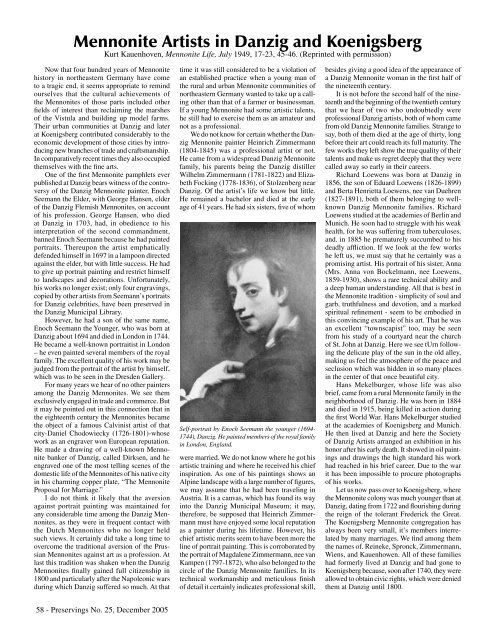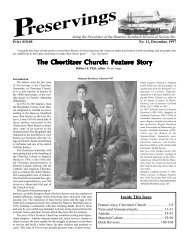Preservings $20 No. 25, December, 2005 - Plett Foundation
Preservings $20 No. 25, December, 2005 - Plett Foundation
Preservings $20 No. 25, December, 2005 - Plett Foundation
Create successful ePaper yourself
Turn your PDF publications into a flip-book with our unique Google optimized e-Paper software.
Mennonite Artists in Danzig and Koenigsberg<br />
Kurt Kauenhoven, Mennonite Life, July 1949, 17-23, 45-46. (Reprinted with permission)<br />
<strong>No</strong>w that four hundred years of Mennonite<br />
history in northeastern Germany have come<br />
to a tragic end, it seems appropriate to remind<br />
ourselves that the cultural achievements of<br />
the Mennonites of those parts included other<br />
fields of interest than reclaiming the marshes<br />
of the Vistula and building up model farms.<br />
Their urban communities at Danzig and later<br />
at Koenigsberg contributed considerably to the<br />
economic development of those cities by introducing<br />
new branches of trade and craftsmanship.<br />
In comparatively recent times they also occupied<br />
themselves with the fine arts.<br />
One of the first Mennonite pamphlets ever<br />
published at Danzig bears witness of the controversy<br />
of the Danzig Mennonite painter, Enoch<br />
Seemann the Elder, with George Hansen, elder<br />
of the Danzig Flemish Mennonites, on account<br />
of his profession. George Hansen, who died<br />
at Danzig in 1703, had, in obedience to his<br />
interpretation of the second commandment,<br />
banned Enoch Seemann because he had painted<br />
portraits. Thereupon the artist emphatically<br />
defended himself in 1697 in a lampoon directed<br />
against the elder, but with little success. He had<br />
to give up portrait painting and restrict himself<br />
to landscapes and decorations. Unfortunately,<br />
his works no longer exist; only four engravings,<br />
copied by other artists from Seemann’s portraits<br />
for Danzig celebrities, have been preserved in<br />
the Danzig Municipal Library.<br />
However, he had a son of the same name,<br />
Enoch Seemann the Younger, who was born at<br />
Danzig about 1694 and died in London in 1744.<br />
He became a well-known portraitist in London<br />
– he even painted several members of the royal<br />
family. The excellent quality of his work may be<br />
judged from the portrait of the artist by himself,<br />
which was to be seen in the Dresden Gallery.<br />
For many years we hear of no other painters<br />
among the Danzig Mennonites. We see them<br />
exclusively engaged in trade and commerce. But<br />
it may be pointed out in this connection that in<br />
the eighteenth century the Mennonites became<br />
the object of a famous Calvinist artist of that<br />
city-Daniel Chodowiecky (1726-1801)-whose<br />
work as an engraver won European reputation.<br />
He made a drawing of a well-known Mennonite<br />
banker of Danzig, called Dirksen, and he<br />
engraved one of the most telling scenes of the<br />
domestic life of the Mennonites of his native city<br />
in his charming copper plate, “The Mennonite<br />
Proposal for Marriage.”<br />
I do not think it likely that the aversion<br />
against portrait painting was maintained for<br />
any considerable time among the Danzig Mennonites,<br />
as they were in frequent contact with<br />
the Dutch Mennonites who no longer held<br />
such views. It certainly did take a long time to<br />
overcome the traditional aversion of the Prussian<br />
Mennonites against art as a profession. At<br />
last this tradition was shaken when the Danzig<br />
Mennonites finally gained full citizenship in<br />
1800 and particularly after the Napoleonic wars<br />
during which Danzig suffered so much. At that<br />
58 - <strong>Preservings</strong> <strong>No</strong>. <strong>25</strong>, <strong>December</strong> <strong>2005</strong><br />
time it was still considered to be a violation of<br />
an established practice when a young man of<br />
the rural and urban Mennonite communities of<br />
northeastern Germany wanted to take up a calling<br />
other than that of a farmer or businessman.<br />
If a young Mennonite had some artistic talents,<br />
he still had to exercise them as an amateur and<br />
not as a professional.<br />
We do not know for certain whether the Danzig<br />
Mennonite painter Heinrich Zimmermann<br />
(1804-1845) was a professional artist or not.<br />
He came from a widespread Danzig Mennonite<br />
family, his parents being the Danzig distiller<br />
Wilhelm Zimmermann (1781-1822) and Elizabeth<br />
Focking (1778-1836), of Stolzenberg near<br />
Danzig. Of the artist’s life we know but little.<br />
He remained a bachelor and died at the early<br />
age of 41 years. He had six sisters, five of whom<br />
Self-portrait by Enoch Seemann the younger (1694-<br />
1744), Danzig. He painted members of the royal family<br />
in London, England.<br />
were married. We do not know where he got his<br />
artistic training and where he received his chief<br />
inspiration. As one of his paintings shows an<br />
Alpine landscape with a large number of figures,<br />
we may assume that he had been traveling in<br />
Austria. It is a canvas, which has found its way<br />
into the Danzig Municipal Museum; it may,<br />
therefore, be supposed that Heinrich Zimmermann<br />
must have enjoyed some local reputation<br />
as a painter during his lifetime. However, his<br />
chief artistic merits seem to have been more the<br />
line of portrait painting. This is corroborated by<br />
the portrait of Magdalene Zimmermann, nee van<br />
Kampen (1797-1872), who also belonged to the<br />
circle of the Danzig Mennonite families. In its<br />
technical workmanship and meticulous finish<br />
of detail it certainly indicates professional skill,<br />
besides giving a good idea of the appearance of<br />
a Danzig Mennonite woman in the first half of<br />
the nineteenth century.<br />
It is not before the second half of the nineteenth<br />
and the beginning of the twentieth century<br />
that we hear of two who undoubtedly were<br />
professional Danzig artists, both of whom came<br />
from old Danzig Mennonite families. Strange to<br />
say, both of them died at the age of thirty, long<br />
before their art could reach its full maturity. The<br />
few works they left show the true quality of their<br />
talents and make us regret deeply that they were<br />
called away so early in their careers.<br />
Richard Loewens was born at Danzig in<br />
1856, the son of Eduard Loewens (1826-1899)<br />
and Berta Henrietta Loewens, nee van Duehren<br />
(1827-1891), both of them belonging to wellknown<br />
Danzig Mennonite families. Richard<br />
Loewens studied at the academies of Berlin and<br />
Munich. He soon had to struggle with his weak<br />
health, for he was suffering from tuberculoses,<br />
and. in 1885 he prematurely succumbed to his<br />
deadly affliction. If we look at the few works<br />
he left us, we must say that he certainly was a<br />
promising artist. His portrait of his sister, Anna<br />
(Mrs. Anna von Bockelmann, nee Loewens,<br />
1859-1930), shows a rare technical ability and<br />
a deep human understanding. All that is best in<br />
the Mennonite tradition - simplicity of soul and<br />
garb, truthfulness and devotion, and a marked<br />
spiritual refinement - seem to be embodied in<br />
this convincing example of his art. That he was<br />
an excellent “townscapist” too, may be seen<br />
from his study of a courtyard near the church<br />
of St. John at Danzig. Here we see tUrn following<br />
the delicate play of the sun in the old alley,<br />
making us feel the atmosphere of the peace and<br />
seclusion which was hidden in so many places<br />
in the center of that once beautiful city.<br />
Hans Mekelburger, whose life was also<br />
brief, came from a rural Mennonite family in the<br />
neighborhood of Danzig. He was born in 1884<br />
and died in 1915, being killed in action during<br />
the first World War. Hans Mekelburger studied<br />
at the academies of Koenigsberg and Munich.<br />
He then lived at Danzig and here the Society<br />
of Danzig Artists arranged an exhibition in his<br />
honor after his early death. It showed in oil paintings<br />
and drawings the high standard his work<br />
had reached in his brief career. Due to the war<br />
it has been impossible to procure photographs<br />
of his works.<br />
Let us now pass over to Koenigsberg, where<br />
the Mennonite colony was much younger than at<br />
Danzig, dating from 1722 and flourishing during<br />
the reign of the tolerant Frederick the Great.<br />
The Koenigsberg Mennonite congregation has<br />
always been very small, it’s members interrelated<br />
by many marriages. We find among them<br />
the names of. Reineke, Spronck, Zimmermann,<br />
Wiens, and Kauenhowen. All of these families<br />
had formerly lived at Danzig and had gone to<br />
Koenigsberg because, soon after 1740, they were<br />
allowed to obtain civic rights, which were denied<br />
them at Danzig until 1800.

















